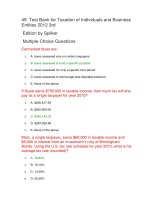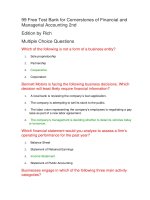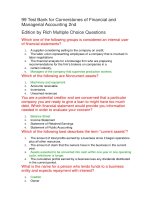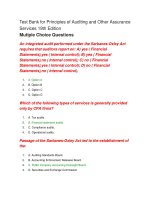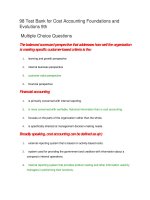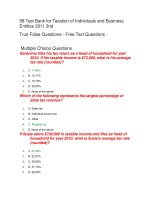98 test bank for taxation of individuals and business entities 2011 2nd
Bạn đang xem bản rút gọn của tài liệu. Xem và tải ngay bản đầy đủ của tài liệu tại đây (129.58 KB, 26 trang )
98 Test Bank for Taxation of Individuals and Business
Entities 2011 2nd
True False Questions - Free Text Questions Multiple Choice Questions
Geronimo files his tax return as a head of household for year
2010. If his taxable income is $72,000, what is his average
tax rate (rounded)?
1.
A. 17.84%
2.
B. 14.17%
3.
C. 19.70%
4.
D. 25.00%
5.
E. None of the above
Which of the following represents the largest percentage of
state tax revenue?
1.
A. Sales tax
2.
B. Individual income tax
3.
C. Other
4.
D. Property tax
5.
E. None of the above
If Susie earns $750,000 in taxable income and files as head of
household for year 2010, what is Susie's average tax rate
(rounded)?
1.
A. 31.58%
2.
B. 32.57%
3.
C. 35.00%
4.
D. 31.13%
5.
E. 28.00%
Marc, a single taxpayer, earns $60,000 in taxable income and
$5,000 in interest from an investment in city of
Birmingham Bonds. Using the U.S. tax rate schedule for
year 2010, what is his average tax rate (rounded)?
1.
A. 18.64%
2.
B. 19.13%
3.
C. 14.30%
4.
D. 25.00%
5.
E. None of the above
The substitution effect:
1.
A. Predicts that taxpayers will work harder to pay for consumer products when tax
rates increase
2.
B. Is one of the effects considered in static forecasting
3.
C. Results in the government collecting more aggregate tax revenue that under the
income effect
4.
D. Is typically more descriptive for taxpayers with lower disposable income
5.
E. None of the above
Which of the following statements is true?
1.
A. Municipal bond interest is subject to explicit federal tax
2.
B. Municipal bond interest is subject to implicit tax
3.
C. Municipal bonds typically pay a higher interest rate than corporate bonds with
similar risk
4.
D. All of the above are true
5.
E. None of the above is true
The city of Granby, Colorado recently enacted a 1.5% surcharge
on vacation cabin rentals that will help pay for the city's
new elementary school. This surcharge is an example of
________.
1.
A. A sin tax to discourage undesirable behavior
2.
B. A government fine
3.
C. An earmarked tax
4.
D. Both A and C
5.
E. None of the above
Marc, a single taxpayer, earns $60,000 in taxable income and
$5,000 in interest from an investment in city of
Birmingham Bonds. Using the U.S. tax rate schedule for
year 2010, what is his current marginal tax rate?
1.
A. 15.00%
2.
B. 25.00%
3.
C. 33.00%
4.
D. 28.00%
5.
E. None of the above
The state of Georgia recently increased its tax on a carton of
cigarettes by $2.00. What type of tax is this?
1.
A. A sin tax
2.
B. An excise tax
3.
C. It is not a tax; it is a fine
4.
D. Both A and B are correct
5.
E. None of the above is correct
Which of the following is true regarding tax-advantaged
assets?
1.
A. They are typically subject to excise taxes to account for their low explicit taxes
2.
B. A corporate bond is typically considered a tax-advantaged asset
3.
C. They are often subject to implicit taxes
4.
D. B and C are correct but not A
5.
E. None of the above
Assume the original facts as given except that Jackson is a
head of household taxpayer and the city of Mitchell pays
interest of 7.8%. How would you advise Jackson to invest
his money?
1.
A. Invest in Sundial, Inc. bonds because their explicit tax is greater than the implicit tax
on city of Mitchell bonds.
2.
B. Invest in city of Mitchell bonds because their implicit tax is greater than the explicit
tax on Sundial, Inc. bonds.
3.
C. Invest in Sundial, Inc. bonds because their explicit tax is less than the implicit tax on
city of Mitchell bonds.
4.
D. Invest in city of Mitchell bonds because their implicit tax is less than the explicit tax
on Sundial, Inc. bonds.
5.
E. None of the above.
What is Manny's current marginal tax rate for year 2010?
1.
A. 33.00%
2.
B. 28.00%
3.
C. 18.50%
4.
D. 23.46%
5.
E. None of the above
Employers often withhold federal income taxes directly from
worker's paychecks. This is an example of which principle
in practice?
1.
A. Convenience
2.
B. Certainty
3.
C. Economy
4.
D. Equity
5.
E. None of the above
To calculate a tax, you need to know: I. the tax base; II. the
taxing agency; III. the tax rate; IV. the purpose of the tax
1.
A. Only I is correct
2.
B. Only IV is correct
3.
C. Only III is correct
4.
D. Items I through IV are correct
5.
E. I and III are correct
If Manny earns an additional $35,000 in taxable income in year
2010, what is his marginal tax rate (rounded) on this
income?
1.
A. 18.95%
2.
B. 28.00%
3.
C. 26.51%
4.
D. 25.00%
5.
E. None of the above
Sin taxes are:
1.
A. taxes assessed by religious organizations
2.
B. taxes assessed on certain illegal acts
3.
C. taxes assessed to discourage less desirable behavior
4.
D. taxes assessed to fund a specific purpose
5.
E. None of the above
The difficulty in calculating a tax is typically in the
determination of:
1.
A. The correct tax rate
2.
B. Where to file the tax return
3.
C. The tax base
4.
D. The due date for the return
5.
E. None of the above
Which of the following is not one of the basic tax rate
structures?
1.
A. Proportional
2.
B. Equitable
3.
C. Regressive
4.
D. Progressive
5.
E. All of the above are different kinds of the basic tax rate structures
Earmarked taxes are:
1.
A. taxes assessed only on certain taxpayers
2.
B. taxes assessed to fund a specific purpose
3.
C. taxes assessed for only a specific time period
4.
D. taxes assessed to discourage less desirable behavior
5.
E. None of the above
Which of the following is not an example of a graduated tax rate
structure?
1.
A. Progressive tax rate structure
2.
B. Proportional tax rate structure
3.
C. U.S. Federal Income Tax
4.
D. Regressive tax rate structure
5.
E. None of the above
What is Leonardo and Theresa's effective tax rate for year 2010
(rounded)?
1.
A. 19.52%
2.
B. 28.00%
3.
C. 25.00%
4.
D. 16.72%
5.
E. None of the above
How much implicit tax would Curtis pay on the city of Athens
bond?
1.
A. $17,500
2.
B. $1,400
3.
C. $1,300
4.
D. $5,000
5.
E. None of the above
Which of the following would not be a failure of the horizontal
equity concept?
1.
A. Two taxpayers with identical income pay different amounts of tax because one
taxpayer's income includes tax exempt interest.
2.
B. Two taxpayers pay different amounts of property tax amounts on similar plots of land
(i.e., same value) because one plot of land is used to raise crops.
3.
C. Two taxpayers pay different amounts of estate tax because one taxpayer's estate is
worth significantly more.
4.
D. All of the above.
5.
E. None of the above.
What is Curtis's after-tax rate of return on the city of Athens
bond?
1.
A. 1.96%
2.
B. 2.52%
3.
C. 7.00%
4.
D. 9.00%
5.
E. None of the above
Leonardo earns $80,000 of taxable income. He also has $15,000
in city of Tulsa bonds. His wife, Theresa, earns $50,000 of
taxable income. If Leonardo and his wife file married filing
jointly in 2010, what would be their average tax rate
(rounded)?
1.
A. 19.20%
2.
B. 28.00%
3.
C. 19.13%
4.
D. 22.76%
5.
E. None of the above
Which of the following is false?
1.
A. A proportional tax rate structure imposes a constant tax rate while a progressive tax
rate structure imposes an increasing marginal rate related to the tax base
2.
B. The average tax rate changes under a proportional tax rate structure, but it is static
for a progressive tax rate system
3.
C. An example of a proportional tax is the tax on gasoline
4.
D. An example of a progressive tax is the federal tax on gifts
5.
E. None of the above
If Susie earns $750,000 in taxable income, how much tax will
she pay as a single taxpayer for year 2010?
1.
A. $236,817.50
2.
B. $262,500.00
3.
C. $240,143.75
4.
D. $287,550.00
5.
E. None of the above
Which of the following is true regarding use taxes?
1.
A. A use tax is relatively easy to enforce compared to a sales tax.
2.
B. Use taxes attempt to eliminate any tax advantage of purchasing goods out of state.
3.
C. Use taxes encourage taxpayers to buy goods out of state to avoid paying sales tax
in their home state.
4.
D. A use tax is generally a progressive tax.
5.
E. None of the above is true.
Which of the following is true regarding real property taxes and
personal property taxes?
1.
A. Personal property taxes are assessed on permanent structures and land
2.
B. Real property taxes are assessed on cars and boats
3.
C. All U.S. states currently impose personal property taxes
4.
D. Real property taxes are generally easier to administer than personal property taxes
5.
E. None of the above is true
Congress recently approved a new, bigger budget for the IRS.
What taxation concept evaluates the cost of administering
our tax law?
1.
A. Convenience
2.
B. Economy
3.
C. Certainty
4.
D. Equity
5.
E. None of the above
Which of the following taxes represents the largest portion of
U.S. Federal Tax revenues?
1.
A. Employment taxes
2.
B. Corporate income taxes
3.
C. Individual income taxes
4.
D. Estate and gift taxes
5.
E. None of the above
The ultimate economic burden of a tax is best captured by:
1.
A. The marginal tax rate
2.
B. The effective tax rate
3.
C. The average tax rate
4.
D. The proportional tax rate
5.
E. None of the above is correct
Which of the following principles encourages a vertically
equitable tax system?
1.
A. Pay as you go
2.
B. Economy
3.
C. Income effects
4.
D. Ability to pay principle
5.
E. None of the above
Which of the following is a tax? I. A 1% special sales tax for
funding local road construction; II. A fee paid to the state
for a license to practice as an attorney; III. An income tax
imposed by Philadelphia on persons working within the
city limits; IV. A special property assessment for installing
a new water system in the taxpayer's neighborhood.
1.
A. Only I is correct.
2.
B. Only IV is correct.
3.
C. Only III is correct.
4.
D. III and IV are correct.
5.
E. I and III are correct.
How much money would Leonardo and Theresa save if they
filed jointly instead of separately for year 2010?
1.
A. Nothing
2.
B. $340.50
3.
C. $423.50
4.
D. $682.50
5.
E. None of the above
If Leonardo earned an additional $30,000 of taxable income this
year, what would be the marginal tax rate (rounded) on the
extra income for year 2010?
1.
A. 28.90%
2.
B. 27.82%
3.
C. 33.00%
4.
D. 38.00%
5.
E. None of the above
Which of the following is true?
1.
A. A regressive tax rate structure imposes an increasing marginal tax rate as the tax
base increases
2.
B. Regressive tax structures are the most common tax rate structure
3.
C. An example of a regressive tax is an excise tax
4.
D. In terms of effective tax rates, a sales tax can be viewed as a regressive tax
5.
E. None of the above
Taxes influence which of the following decisions?
1.
A. Business decisions
2.
B. Personal decisions
3.
C. Political decisions
4.
D. Investment decisions
5.
E. All of the above
Marc, a single taxpayer, earns $60,000 in taxable income and
$5,000 in interest from an investment in city of
Birmingham Bonds. Using the U.S. tax rate schedule for
year 2010, how much federal tax will he owe?
1.
A. $15,000.00
2.
B. $12,431.25
3.
C. $11,181.25
4.
D. $8,581.25
5.
E. None of the above
Margaret was issued a $150 speeding ticket. This is:
1.
A. A tax because payment is required by law
2.
B. A tax because the payment is not related to any specific benefit received from the
government agency collecting the ticket
3.
C. Not a tax because it is considered a fine intended to punish illegal behavior
4.
D. A tax because it is imposed by a government agency
5.
E. Not a tax because Margaret could have avoided payment if she did not speed
If Curtis invested in the Initech, Inc. bonds, what would be his
after-tax rate of return from this investment?
1.
A. 5.04%
2.
B. 7.00%
3.
C. 6.48%
4.
D. 2.52%
5.
E. None of the above
Which of the following federal government actions would make
sense if a tax system fails to provide sufficient tax
revenue?
1.
A. Issue treasury bonds
2.
B. Cut funding to various federal projects
3.
C. Increase federal spending
4.
D. A and B but not C
5.
E. None of the above
Marc, a single taxpayer, earns $60,000 in taxable income and
$5,000 in interest from an investment in city of
Birmingham Bonds. Using the U.S. tax rate schedule for
year 2010, what is his effective tax rate (rounded)?
1.
A. 23.08%
2.
B. 17.20%
3.
C. 13.20%
4.
D. 19.13%
5.
E. None of the above
The concept of tax sufficiency:
1.
A. Suggests the need for tax forecasting
2.
B. Suggests that a government should estimate how taxpayers will respond to changes
in the current tax structure
3.
C. Suggests that a government should consider the income and substitution effects
when changing tax rates
4.
D. All of the above
5.
E. None of the above
Which of the following is considered a tax?
1.
A. Tolls
2.
B. Parking meter fees
3.
C. Annual licensing fees
4.
D. A local surcharge paid on retail sales to fund public schools
5.
E. Entrance fees paid at national parks
How much explicit tax would Curtis incur on interest earned on
the Initech, Inc bond?
1.
A. $16,200
2.
B. $6,300
3.
C. $4,900
4.
D. $12,600
5.
E. None of the above
Eliminating the current system of withholding income taxes
directly from employee paychecks would:
1.
A. Violate the convenience criterion of federal taxation
2.
B. Increase the rate of compliance
3.
C. Make collection of federal income taxes easier
4.
D. All of the above
5.
E. None of the above
If Leonardo instead had $30,000 of additional tax deductions for
year 2010, his marginal tax rate (rounded) on the
deductions would be:
1.
A. 28.00%
2.
B. 25.00%
3.
C. 36.46%
4.
D. 27.96%
5.
E. None of the above
What interest rate would the city of Mitchell have to pay in order
to make Jackson indifferent between investing in the city
of Mitchell and the Sundial, Inc. bonds for year 2010?
1.
A. 7.50%
2.
B. 10.00%
3.
C. 8.00%
4.
D. 7.20%
5.
E. None of the above
True - False Questions
Margaret recently received a parking ticket. This is a common
example of a local tax.
1.
True
2.
False
Tax policy rarely plays an important part in presidential
campaigns.
1.
True
2.
False
The effective tax rate expresses the taxpayer's total tax as a
percentage of the taxpayer's taxable and nontaxable
income.
1.
True
2.
False
Regressive tax rate structures are typically considered to be
vertically equitable.
1.
True
2.
False
In addition to raising revenues, specific U.S. taxes may have
other objectives (e.g., economic or social objectives).
1.
True
2.
False
One benefit of a sin tax (e.g., a tax on cigarettes) is that it
should increase the demand for the products being
taxed.
1.
True
2.
False
The two components of the tax calculation are the tax rate and
the taxpayer.
1.
True
2.
False
Estimated tax payments are one way the federal income tax
system addresses the "certainty" criterion in evaluating
tax systems.
1.
True
2.
False
Common examples of sin taxes include the taxes imposed on
airline tickets and gasoline.
1.
True
2.
False
In a regressive tax rate system, the marginal tax rate will often
be greater than the average tax rate.
1.
True
2.
False
Relative to explicit taxes, implicit taxes are much easier to
estimate.
1.
True
2.
False
Self employment taxes are charged on self employment income
in addition to any federal income tax.
1.
True
2.
False
Implicit taxes are indirect taxes on tax-favored assets.
1.
True
2.
False
Horizontal equity is defined in terms of taxpayers in similar
situations whereas vertical equity is defined in terms of
taxpayers in different situations.
1.
True
2.
False
The estate tax is assessed based on the fair market values of
transfers made during a taxpayer's life.
1.
True
2.
False
While sales taxes are quite common, currently the U.S. federal
government does not impose a sales tax.
1.
True
2.
False
A use tax is typically imposed by a state on goods purchased
within the state.
1.
True
2.
False
The tax base for the federal income tax is taxable income.
1.
True
2.
False
A sales tax is a common example of a progressive tax rate
structure.
1.
True
2.
False
In a proportional (flat) tax rate system, the marginal tax rate will
always equal the average tax rate.
1.
True
2.
False
Taxes influence many types of business decisions but generally
do not influence personal decisions.
1.
True
2.
False
A taxpayer's average tax rate is the most appropriate tax rate to
use in tax planning.
1.
True
2.
False
A common example of an employment related tax is the
Medicare tax.
1.
True
2.
False
In considering the "economy" criterion in evaluating tax
systems, one must consider this criterion from both the
taxpayer and the government's perspective to best
evaluate this criterion.
1.
True
2.
False
The main difficulty in calculating an income tax is determining
the correct amount of the tax base.
1.
True
2.
False
The income and substitution effects are two opposing effects
that one could consider in static forecasting.
1.
True
2.
False
Taxes influence business decisions such as where a business
should locate or how a business should be structured.
1.
True
2.
False
A 1% charge imposed by a local government on football tickets
sold is not considered a tax if all proceeds are earmarked
to fund local schools.
1.
True
2.
False
In terms of effective tax rates, the sales tax can be viewed as a
regressive tax.
1.
True
2.
False
A flat tax is an example of a graduated tax system.
1.
True
2.
False
The 9th Amendment to the U.S. Constitution removed all doubt
that a federal income tax was allowed under the U.S.
Constitution.
1.
True
2.
False
The largest federal tax, in terms of revenue collected, is the
social security tax.
1.
True
2.
False
Excise taxes are typically levied on the value of a good
purchased.
1.
True
2.
False
One key characteristic of a tax is that it is a required payment to
a governmental agency.
1.
True
2.
False
Property taxes may be imposed on both real and personal
property.
1.
True
2.
False
Dynamic forecasting does not take into consideration
taxpayers' responses to a tax change when estimating tax
revenues.
1.
True
2.
False
The effective tax rate, in general, provides a better depiction of a
taxpayer's tax burden than the average tax rate.
1.
True
2.
False
George recently paid $50 to renew his driver's license. The $50
payment is considered a tax.
1.
True
2.
False
Free Text Questions
Milton and Rocco are having a heated debate regarding a
national sales tax. Milton argues that a national sales tax
is a proportional, vertically equitable tax. Rocco argues
that a national sales tax would be a regressive, vertically
inequitable tax. Explain both sides of the argument.
Answer Given
A sales tax by definition is a proportional tax - i.e., as taxable purchases increase, the
sales tax rate (i.e., the marginal tax rate) remains constant. For this reason, Milton is
correct. Nonetheless, when you consider that the proportion of one's total income
spent on taxable purchases likely decreases as total income increases, the sales tax
may be considered a regressive tax. For this reason, Rocco is correct. Vertical equity
is achieved when taxpayers with greater ability to pay tax pay more tax relative to
taxpayers with a lesser ability to pay tax. One can view vertical equity in terms of tax
dollars paid or in terms of tax rates. Proponents of a sales tax (e.g., Milton) are more
likely to argue that vertical equity is achieved when taxpayers with a greater ability to
pay tax pay more in tax dollars. Opponents of a national sales tax (e.g., Rocco) are
more likely to argue that taxpayers with a greater ability to pay should be subject to a
higher tax rate. This view is based upon the argument that the relative burden of a
sales tax decreases as a taxpayer's income (e.g., disposable income) increases.
Evaluate the U.S. federal tax system on the certainty and
economy criteria.
Answer Given
Certainty means that taxpayers should be able to determine when to pay the tax,
where to pay the tax, and how to determine the tax. It is relatively easy to determine
when and where to pay the federal income tax. For example, individual federal income
tax returns and the remaining balance of taxes owed must be filed with the Internal
Revenue Service each year on or before April 15th (or the first business day following
April 15th). Thus, from this perspective, the federal income tax scores high. However,
the federal income tax is often criticized as being complex. What are
taxable/nontaxable forms of income? What are deductible/nondeductible expenses?
When should income or expense be reported? For many taxpayers (e.g., wage
earners with few investments), the answers to these questions are straightforward. For
other taxpayers (e.g., business owners, individuals with a lot of investments), the
answers to these questions are nontrivial. Constant tax law changes enacted by
Congress also add to the difficulty in determining the proper amount of income tax to
pay. These changes can make it difficult to determine a taxpayer's current tax liability
much less plan for the future. From this perspective of "certainty", the federal income
tax system does not fare so well. Economy requires that a good tax system should
minimize the compliance and administration costs associated with the tax system.
Economy can be viewed from both the taxpayers' and government's perspectives.
From the government's perspective, the federal tax system fares well with respect to
economy. For example, the current IRS budget represents approximately ½ of a
percent of every tax dollar collected. Compared to the typical costs of a collection
agency, this is quite a low percentage cost. From the taxpayer's perspective of
economy, the federal income tax does not fare so well. The income tax is often
criticized for the compliance costs imposed on the taxpayer. Indeed, for certain
taxpayers, record-keeping costs, accountant fees, attorney fees, etc. can be quite
substantial.
Although the primary purpose of a tax system is to raise
revenue, Congress uses the federal tax system for other
purposes as well. Describe the other ways in which
Congress uses the federal tax system. Be specific.
Answer Given
In addition to the general objective of raising revenue, Congress uses the federal tax
system to encourage certain behavior and discourage other behavior. The charitable
contribution deduction is intended to encourage taxpayers to support the initiatives of
charitable organizations (social objective) whereas deductions for retirement
contributions are intended to encourage retirement savings (social objective). Taxes
are also often used to encourage investment and stimulate the economy. Likewise,
taxes are also used to discourage certain less desirable taxpayer behavior. For
example, "sin taxes" impose relatively high surcharges on alcohol and tobacco
products to discourage their use.
Nelson has the choice between investing in a city of Fruithurst
bond at 4% or a J.B. Ribs, Inc. bond at 6.5%. Assuming
that both bonds have the same non-tax characteristics
and that Nelson has a 40% marginal tax rate, in which
bond should he invest? What interest rate offered by J.B.
Ribs, Inc. would make Nelson indifferent between
investing in the two bonds?
Answer Given
Nelson's after tax rate of return on the tax exempt city of Fruithurst bond is 4%. The
J.B. Ribs, Inc. bond pays taxable interest of 6.5%. Nelson's after tax rate of return on
the J.B. Ribs, Inc. bond is 3.9% (i.e., 6.5% interest income - (6.5% x 40%) tax = 3.9%).
Nelson should invest in the city of Fruithurst bond. To be indifferent between investing
in the two bonds, the J.B. Ribs, Inc. bond should provide Nelson the same after-tax
rate of return as the city of Fruithurst bond (4%). To solve for the required pre-tax rate
of return we can use the following formula: After-tax return = Pre-tax return x (1 Marginal Tax Rate). J.B. Ribs, Inc. needs to offer a 6.67% interest rate to generate a
4% after-tax return and make Nelson indifferent between investing in the two bonds i.e., 4% = Pre-tax return x (1 - 40%); Pre-tax return = 4%/(1 - 40%) = 6.67%
Congress would like to increase tax revenues by 20 percent.
Assume that the average taxpayer in the United States
earns $80,000 and pays an average tax rate of 17.5%. If
the income effect is descriptive for all taxpayers, what
average tax rate will result in a 20 percent increase in tax
revenues? This is an example of what type of
forecasting?
Answer Given
Based on the information above, the average taxpayer pays $14,000 of tax (i.e.,
$80,000 x 17.5%), leaving $66,000 of income after tax. A 20 percent increase in
revenues would mean that the average taxpayer pays $16,800 in tax ($14,000 x 1.20).
With this new tax amount, we can solve for the tax rate that would generate this tax
amount. After-tax income = Pre-tax income x (1 - tax rate); After-tax income = Pre-tax
income - (Pre-tax income x tax rate); After-tax income = Pre-tax income - Tax
Substituting information from the problem results in: $66,000 = Pre-tax income -
$16,800; Pre-tax income = $82,800; We can use the above formula to solve for the
new tax rate. After-tax income = Pre-tax income x (1 - tax rate) $66,000 = $82,800 x (1
- tax rate); Tax rate = $16,800/$82,800 = 20.29%. This is an example of dynamic
forecasting.
Oswald is beginning his first tax course and does not really
have a solid understanding of the role that taxes play in
various decisions. Please describe for Oswald the various
types of decisions that taxes may influence.
Answer Given
Taxes are a part of everyday life and have a financial effect on many of the major
personal decisions that individuals face (e.g., investment decisions, evaluating
alternative job offers, saving for education expenses, gift or estate planning, etc.).
Taxes play an equally important role in fundamental business decisions such as the
following: • What organizational form should a business use? Where should the
business locate?; • How should business acquisitions be structured?; • How should
employees be compensated? What is the appropriate mix of debt and equity for the
business?; • Should the business rent or own equipment and property?; • How should
the business distribute profits to its owners?. Savvy business decisions require
consideration of all costs and benefits in order to evaluate the merits of a transaction.
Although taxes do not necessarily dominate these decisions, they do represent large
transaction costs that should be factored into the financial decision-making process.
Taxes also play a major part in the political process. U.S. presidential candidates often
distinguish themselves from their opponents based upon their tax rhetoric. Indeed, the
major political parties generally have very diverse views of the appropriate way to tax
the public. Voters must have a basic understanding of taxes to evaluate the merits of
alternative tax proposals.
Ricky and Lucy are debating several types of taxes. Their
debate has focused on the different types of tax rate
structures and whether they are "fair." Please define each
tax rate structure, provide examples of each structure,
and discuss how each structure may be viewed with
respect to vertical equity.
Answer Given
A proportional (flat) tax rate structure imposes a constant tax rate throughout the tax
base. Common examples of proportional taxes include sales taxes and excise taxes
(i.e., taxes based on quantity such as gallons of gas purchased). A progressive tax
rate structure imposes an increasing marginal tax rate as the tax base increases.
Common examples of progressive tax rate structures include federal and state income
taxes and federal estate and gift taxes. A regressive tax rate structure imposes a
decreasing marginal tax rate as the tax base increases. Regressive tax rate structures
are not common. In the United States, the Social Security tax and federal and state
unemployment taxes employ a regressive tax rate structure. However, there are other
regressive taxes when the tax is viewed in terms of effective tax rates. For example, a
sales tax by definition is a proportional tax - i.e., as taxable purchases increase, the
sales tax rate (i.e., the marginal tax rate) remains constant. Nonetheless, when you
consider that the proportion of one's total income spent on taxable purchases likely
decreases as total income increases, the sales tax may be considered a regressive
tax. One can view vertical equity in terms of tax dollars paid or in terms of tax rates.
Proponents of proportional tax rate structures are more likely to argue that vertical
equity is achieved when taxpayers with a greater ability to pay tax simply pay more in
tax dollars. Thus, from this view, a proportional tax rate achieves vertical equity.
Proponents of a progressive tax system are more likely to argue that taxpayers with a
greater ability to pay should be subject to a higher tax rate. This view is based upon
the argument that the relative burden of a flat tax rate decreases as a taxpayer's
income increases. Thus, vertical equity is achieved only when taxpayers with a greater
ability to pay are subject to a higher tax rate. Regressive tax rate structures are
generally considered not to satisfy vertical equity (unless one is a strong advocate of
the belief that those with a greater ability to pay do so simply by paying more tax
dollars, albeit at a lower tax rate).
Bart is contemplating starting his own business. His new
business would operate as a sole proprietorship and
would require hiring several employees. Describe the
employment-related taxes that Bart should be aware of as
he starts his new business as a self-employed business
owner.
Answer Given
Employment taxes consist of the Old Age, Survivors, and Disability Insurance (OASDI)
tax, commonly called Social Security tax, and the Medical Health Insurance (MHI) tax
known as the Medicare tax. The Social Security tax pays the monthly retirement,
survivor, and disability benefits for qualifying individuals, whereas the Medicare tax
pays for medical insurance for individuals who are elderly or disabled. The tax base for
the Social Security and Medicare taxes is wages or salary, and the rates are 12.4%
and 2.9%, respectively. Employers and employees split this tax equally. Thus, Bart will
have to pay the employer's portion of these taxes for his employees. As a selfemployed individual, Bart must pay also the self-employment tax, which is basically
the same as the employer's and employee's share of the Social Security and Medicare
taxes. The tax rates for these taxes are 12.4% and 2.9%, respectively, and the tax
base is net self-employment income. The self-employment tax is in addition to any
federal income tax owed by the individual. In addition to the Social Security and
Medicare taxes, employers are also required to pay federal and state unemployment
taxes, which fund temporary unemployment benefits for individuals terminated from
their jobs without cause. The tax base for the unemployment taxes is also wages or
salary.
Namratha has the choice between investing in a city of
Watkinsville bond at 4.5% or a Moe's, Inc. bond at 7%.
Assuming that both bonds have the same non-tax
characteristics and that Namratha has a 25% marginal tax
rate, in which bond should she invest? What interest rate
offered by Moe's, Inc. would make Namratha indifferent
between investing in the two bonds?
Answer Given
Namratha's after tax rate of return on the tax exempt city of Watkinsville bond is 4.5%.
The Moe's, Inc. bond pays taxable interest of 7%. Namratha's after tax rate of return
on the Moe's, Inc. bond is 5.25% (i.e., 7% interest income - (7% x 25%) tax = 5.25%).
Namratha should invest in the Moe's, Inc. bond. To be indifferent between investing in
the two bonds, the Moe's, Inc. bond should provide Namratha the same after-tax rate
of return as the city of Watkinsville bond (4.5%). To solve for the required pre-tax rate
of return we can use the following formula: After-tax return = Pre-tax return x (1 Marginal Tax Rate). Moe's, Inc. needs to offer a 6% interest rate to generate a 4.5%

